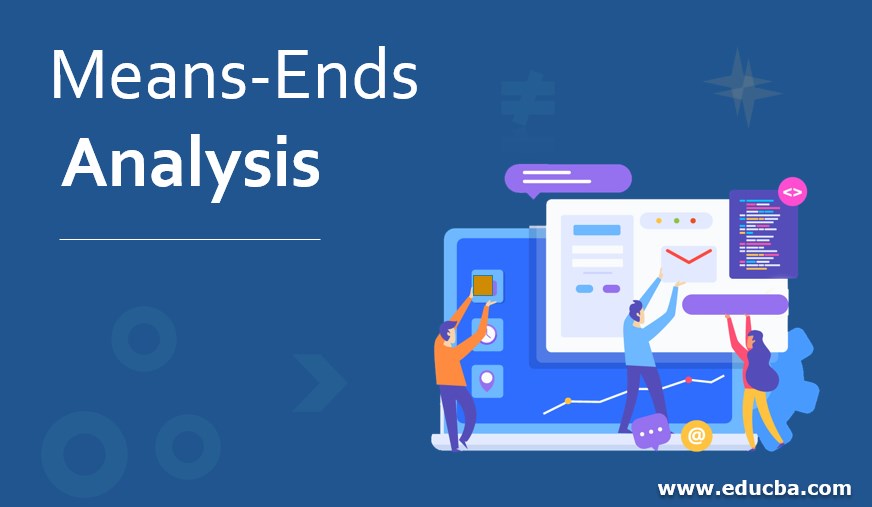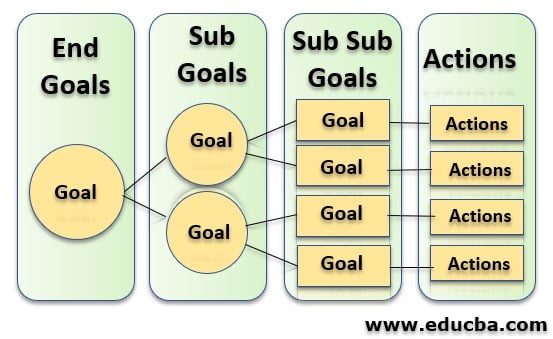Updated June 28, 2023

Introduction to Means-Ends Analysis
Means-End Analysis is a problem-solving technique that identifies the current state, defines the end goal, and determines the modular action plan to reach the end state. Split the End Goals into sub-goals and sub-sub goals, and then draw action plans to achieve sub-goals first and then progress towards achieving the main goal. Most of the problem-solving strategies will have either forward actions or backward actions.
But MEA will have a mixture of action plans in either of the directions to solve the problems modularly, in the sense that it attempts to solve the significant problems first and get back to minor issues later or vice versa. Means-End Analysis (MEA) finds application in AI programming, General Management, and Psychology as a problem-solving technique. Let us study its features in detail in this article.
What is Problem Solving?
Problem-solving has a different meaning in several contexts. As part of Artificial Intelligence, computer science refers to applying algorithms, heuristics, and root cause analysis to find solutions. Psychology deals with the logic of cognitively reaching a desired goal state from the problematic current state through introspection, analysis, and experimentation.
The problem-solving activity starts with gathering data on the problem using surveys, Brainstorming, and identifying gaps. Failure Mode Effects analysis helps to identify potential problems in a system. The next step involves analyzing the gathered data using tools such as the Fishbone diagram, Pareto chart, etc., to identify a solution.
Where is it used?
Means-End Analysis is used in the following disciplines:
- MEA is a creative problem-solving technique used in Artificial Intelligence applications for a long time. From the search space of possible solutions available in the system, AI selects the best possible solution by applying the right search strategy or algorithm. This algorithm deals with an initial and end state, the action plan, and movement in forward and backward directions. This recursive algorithm optimizes the search operation and achieves the end goal with minimum effort.
- In the General Management area, MEA facilitates organization planning to attain goals. We split goals into objectives and then divide each objective into action steps. Breaking goals into actionable tasks helps management reach the end state successfully.
- MEA helps implement Business transformation projects by identifying as it is a state, defining to state, and listing the new business processes to be developed. For effective implementation, further split these new processes into sub-processes.
- One can also follow the MEA methodology to solve problems or attain a specific goal. It helps to manage overwhelming situations by clearly understanding the reasons for the current status and reaching the end status by executing the planned actions. MEA helps in avoiding frustrations and mental depression and leading a peaceful life.
How does the Means-Ends Analysis work?
Let’s learn how it works.
- Measures the current state and identifies the problems and pain points faced in the current state.
- Defines the to-be state (goal state) to be reached.
- Splits the goals into sub-goals and sub-goals into further sub-sub-goals. To illustrate, we can divide long-term goals into short-term goals and continue the subdivision process.
- The desired outcome requires identifying the necessary steps to achieve it.
- Connect each sub-goal with executable actions.
- Includes all intermediate steps and relevant actions to address the issues faced in the current state.
- It makes these steps detectable and device ways and means to track even small changes in the actual and to-be state.
Takes corrective actions wherever it is required MEA steps are depicted below:
Algorithm for Means-Ends Analysis
The algorithm provides the best possible solution to a problem and contains the well-defined step-by-step correct resolution to a given problem. One should blindly follow this mathematical template of steps and expect it to produce the end results. We can use these algorithms as input to develop computer programs and implement solutions. Each and every step can have test cases built for it, and the program can undergo thorough testing before implementation. When solving a problem, logical steps guarantee a solution. In contrast, heuristics rely on trial and error, past experience, and judgmental methods, which may not always produce a guaranteed solution.
In general, we use algorithms where we expect accurate results and where the time to complete the activity is not a significant criterion. When completing tasks, people use heuristics to save time and can tolerate a few errors. In planned activity (e.g., Organization Planning), we deploy algorithms; in emergency activity (e.g., a Physician treating a patient should decide on the treatment quickly), we use heuristics.
The algorithm for MEA consists of the following steps:
- Step 1: Measure the current state of things by doing as is the study and capture the status at a macro level and a possible micro level.
- Step 2: Capture the deficiency in the current state and avenues for improvements (wish list) and define the goal state (to-be state). Define the to-be state at a macro level and a possible micro level.
- Step 3: Compare the Current and Goal states; if they are at the same level, the problem is resolved.
- Step 4: List the differences between the current and goal states at macro and micro levels.
- Step 5: Convert the differences into deletions/modifications to the current state and new additions.
- Step 6: Define the action to implement the changes as defined in step-5.
- Step 7: Implement the changes and measure the results with the planned goals.
- Step 8: Do course correction and achieve the final goal.
Artificial Intelligence applications, General Management scenarios, and phycology use cases to deploy the MEA algorithm step selectively and recursively in achieving the end goal.
Conclusion
The means-End analysis provides a logical action plan to overcome any problems in General Management, Personal life. In AI, MEA offers a methodology to optimize search operations to save time and effort.
Recommended Articles
This is a guide to the Means-Ends Analysis. Here we discuss how it is used, working and the algorithm of Means-Ends Analysis. You may also look at the following articles to learn more-


